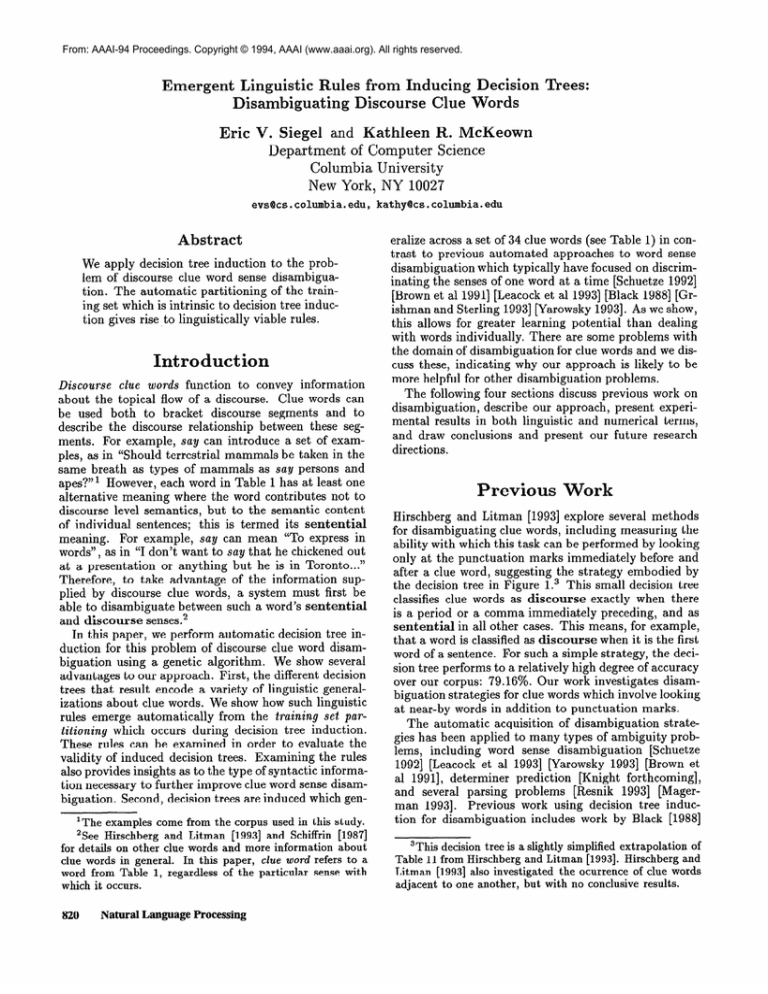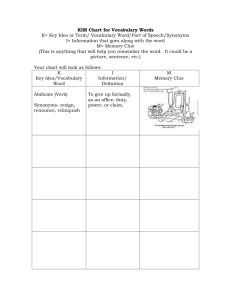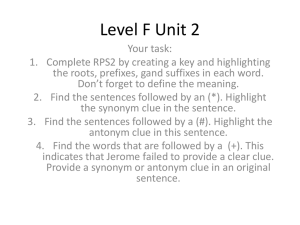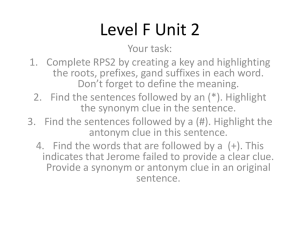
From: AAAI-94 Proceedings. Copyright © 1994, AAAI (www.aaai.org). All rights reserved.
Emergent
Linguistic Rules from Inducing Decision
Disambiguating
Discourse Clue Words
Trees:
Eric V. Siegel and Kathleen R. McKeown
Department of Computer Science
Columbia University
New York, NY 10027
evs@cs.columbia.edu,
Abstract
We apply decision tree induction to the problem of discourse clue word sense disambiguation. The automatic partitioning of the training set which is intrinsic to decision tree induction gives rise to linguistically viable rules.
Introduction
clue words function to convey information
about the topical flow of a discourse. Clue words can
be used both to bracket discourse segments and to
describe the discourse relationship between these segments. For example, say can introduce a set of examples, as in “Should terrestrial mammals be taken in the
same breath as types of mammals as say persons and
apes.7”1 However, each word in Table 1 has at least one
alternative meaning where the word contributes not to
discourse level semantics, but to the semantic content
of individual sentences; this is termed its sentential
meaning. For example, say can mean “To express in
words”, as in “I don’t want to say that he chickened out
at a presentation or anything but he is in Toronto...”
Therefore, to take advantage of the information supplied by discourse clue words, a system must first be
able to disambiguate between such a word’s sentential
and discourse senses.2
In this paper, we perform automatic decision tree induction for this problem of discourse clue word disambiguation using a genetic algorithm. We show several
advantages to our approach. First, the different decision
trees that result encode a variety of linguistic generalizations about clue words. We show how such linguistic
rules emerge automatically from the training set purtitioning which occurs during decision tree induction.
These rules can be examined in order to evaluate the
validity of induced decision trees. Examining the rules
also provides insights as to the type of syntactic information necessary to further improve clue word sense disambiguation. Second, decision trees are induced which gen-
Discourse
‘The examples come from the corpus used in this study.
2See Hirschberg and Litman [1993] and Schiffrin [1987]
for details on other clue words and more information about
clue words in general. In this paper, clue world refers to a
word from Table 1, regardless of the particular sense with
which it occurs.
820
Natural Language
Processing
kathy@cs.columbia.edu
eralize across a set of 34 clue words (see Table 1) in contrast to previous automated approaches to word sense
disambiguation which typically have focused on discriminating the senses of one word at a time [Schuetze 19921
[Brown et al 19911 [Leacock et al 19931 [Black 19881 [Grishman and Sterling 19931 [Yarowsky 19931. As we show,
this allows for greater learning potential than dealing
with words individually. There are some problems with
the domain of disambiguation for clue words and we discuss these, indicating why our approach is likely to be
more helpful for other disambiguation problems.
The following four sections discuss previous work on
disambiguation, describe our approach, present experimental results in both linguistic and numerical terms,
and draw conclusions and present our future research
directions.
Previous Work
Hirschberg and Litman [1993] explore several methods
for disambiguating clue words, including measuring the
ability with which this task can be performed by looking
only at the punctuation marks immediately before and
after a clue word, suggesting the strategy embodied by
the decision tree in Figure 1.3 This small decision tree
classifies clue words as discourse exactly when there
is a period or a comma immediately preceding, and as
sentential in all other cases. This means, for example,
that a word is classified as discourse when it is the first
word of a sentence. For such a simple strategy, the decision tree performs to a relatively high degree of accuracy
over our corpus: 79.16%. Our work investigates disambiguation strategies for clue words which involve looking
at near-by words in addition to punctuation marks.
The automatic acquisition of disambiguation strategies has been applied to many types of ambiguity problems, including word sense disambiguation [Schuetze
19921 [Leacock et al 19931 [Yarowsky 19931 [Brown et
al 19911, determiner prediction [Knight forthcoming],
and several parsing problems [Resnik 19931 [Magerman 19931. Previous work using decision tree induction for disambiguation includes work by Black [1988]
3This decision tree is a slightly simplified extrapolation of
Table 11 from Hirschberg and Litman [1993]. Hirschberg and
Litman [1993] also investigated the ocurrence of clue words
adjacent to one another, but with no conclusive results.
Table 1: Discourse clue words and the fraction of times each is used in its discourse
Clue word
and
now
Fraction
1371348
64175
Clue word
see
actually
Ze
but
or
say
well
look
55/74
6171
27156
17155
25136
13135
of35
first
also
then
further
finarlly
right
because
Fraction
o/29
l/29
O/25
5/20
6115
8/14
11/u
Q/10
o/10
Clue word
no
although
indeed
OK
however
generally
similarly
basically
second
-1
;:)I::
. I
D
<default>
Clue word
next
yes
since
except
therefore
otherwise
anyway
sense.
Fraction
o/4
o/3
o/3
o/3
o/2
111
O/l
0
say an
A
S
Figure 1: Manually created decision tree with accuracy
79.16%.
(word sense disambiguation), Knight [forthcoming] (determiner prediction), Resnik [19931 (coordination parsing) and Magerman [1993] (syntactic parsing). Automatic approaches to word sense disambiguation have
thus far primarily focussed on disambiguating one word
at a time.
Approach
In this study, we expand on the orthographic approach
to clue word disambiguation described by Hirschberg
and Litman [1993] by allowing decision trees to test not
only for adjacent punctuation marks and clue words,
but also for near-by words of any kind, and by allowing
the decision trees to discriminate between clue words.
The set of attributes available to a decision tree are the
tokens (words and punctuation marks) appearing immediately to the left of the ambiguous word, immediately
to the right of the ambiguous word, and 2, 3, and 4
spaces to the right of the ambiguous word, as well as
the ambiguous word itself (attribute Q), that is, (-1, 0,
1, 2, 3, 4). This set of attributes were selected to test
whether the decision trees would find a wider window
of tokens useful for clue word disambiguation, but, as
was automatically determined, only the adjacent tokens
and the ambiguous word itself were deemed useful. No
information describing. syntactic structure is explicitly
available to decision trees. The genetic algorithm determines automatically which words or punctuation in
these positions are important for disambiguation.
Decision
Fraction
o/9
519
518
818
w
116
v
l/5
O/4
Trees
Figures 2 and 3 show example decision trees which were
automatically induced for clue word sense disambiguation. Internal nodes are labeled with token positions
t>
>
Figure 2: Decision tree automatically induced by the genetic algorithm. This tree disambiguated with 81.10%
accuracy over the training set, and-with 82.30% accuracy over the test set.
(attributes),
arcs are labeled with sets of tokens (dues), and leaves are labeled with classes, that is, either
discourse or sentential.
Given a text fragment con-
taining a clue word, a decision tree classifies the word
as to its sense by a deterministic traversal of the tree,
starting at the root, down to a leaf. During traversal,
an arc descending from the current (internal) node is
selected in order to continue the traversal. This arc is
chosen by finding the first descending arc, going from
left to right, containing the token at the text fragment
position indicated by the current node’s label. For example, to traverse the tree in Figure 2, starting at the
root node, the leftmost arc is traversed if the word at
position 0 is one of the words on the arc (e.g., say).
The rightmost arc under each internal node is labeled
“default”, and is traversed when none of its sister arcs
contain the correct token.
In order to increase the likelihood that an induced decision tree will embody valid generalizations, as opposed
to being over-fitted to the particular set of training examples, only the tokens which appear with frequency
above a threshold of 15 in the training cases are permitted in the value sets of a decision tree (see the subsection
“The Training Data” for details on the training corpus),
Discourse
821
Figure 3: Decision tree automatically induced by the genetic algorithm.
accuracy over the training set, and with 82.30% accuracy over the test set.
specifically:*
{<period>,
<comma>, <apostrophe-s>,
This tree disambiguated with 84 .99%
Table 2: Example training cases.
a, and, are, as,
at, can, fur, I, in, is, it, of, that, the, this, to, we, you}
A separate set of tokens is available to the arcs under
nodes labeled 0, namely the discourse clue words which
appear with frequency greater than 4 in the training
cases. (Only clue words appear at position 0.) This
threshold was chosen to allow infrequent clue words to
be specified by a decision tree, but to still avert overfitting to the training data.
Decision
Tree Induction
The corpus used in this study supplies 1,027 examples.
Table 2 shows sample data. Each training case has a
manually specified class, and a value corresponding to
each of 6 attributes. In order to predict the performance
of an induced decision tree over unseen data, the induction procedure is run over a random half of the corpus
(the training set), and the resulting decision tree is then
evaluated over the remaining half of the corpus (the test
set). This division of the data is performed randomly
before each run.5
The induction procedure used in this study is a genetic algorithm (GA) [Holland 19751, a weak learning
method which has been applied to a wide range of tasks
in optimization, machine learning, and automatic com*Tokens are case-insensitive (capitalization doesn’t matter), but inflection-sensitive (a is different than CJPZ).
5Because of this random division, the frequency distribution of tokens in the training set varies, so the valid token
and clue word sets actually varies slightly.
822
Natural
Language Processing
~1
puter program induction [Goldberg 19891 [Koza 19921.
Inspired by Darwinian survival of the fittest, the GA
works with a pool (popuZution) of individuals, stochastitally performing reproductive operators on the individuals, depending on some notion of fitness. Reproductive
operators include crossover, a stochastic procedure by
which two individuals are combined to create a third,
and mutation, by which an individual undergoes a random alteration. In our work, individuals are both decision trees and the token sets which correspond to decision tree arcs. Fitness corresponds to the number of
training cases correctly classified by a decision tree. The
GA outputs the highest fit decision tree it encounters.
Siegel [1994] describes the details of GA decision tree
induction applied in this work. Subsection “Numerical
Results” in this paper contrasts GA decision tree induction to classical decision tree induction techniques.
The Training
Data
The 1,027 training examples come from a corpus used
by Hirschberg and Litman [1993]. This is a transcript
of a single speaker speech, preceeded by introductory
remarks by other speakers, in which each occurrence of
the words in Table 1 has been manually marked as to its
meaning by a linguist.6 When marking the corpus, the
linguist had access to the entire transcript plus a recording of the speech. Therefore, much more information
was available to the linguist than there is to a decision
tree. Regardless, about 7% were deemed ambiguous by
the linguist. The “ambiguous” examples were left out
of this study since they provide no information on how
to disambiguate. 407 of the 1,027 unambiguous lexical items (39.63Y)o were marked as discourse, and 620
(60.37%) were marked as sentential.
See Hirschberg
and Litman [1993] for more detail on the corpus and
the distribution of data within it.
Results
Since the division between training and test cases is
random for each run, and since the GA is a stochastic method, each run of the GA gives rise to a unique
decision tree.7 We performed 58 runs, thus generating
58 trees. We evaluate these trees in two ways. First, by
manually examining several high scoring trees, we show
they yield linguistically valid rules. Second, we measure
the average performance of induced decision trees.
Linguistic
Results
The small decision tree in Figure 1, a tree obtained manually by Hirschberg and Litman [1993], yields an accuracy of 79.16%. To attain any improvement in accuracy,
a more complex partitioning of the training cases must
take place, by which the GA focuses on the cases where
the majority of error lies. It is by this partitioning process that additional linguistic rules are induced.
A decision tree implicitly partitions the training (and
test) cases; each rule embedded in a decision tree corresponds to a partition. As an example, the small decision
tree in Figure 1 corresponds to the following simple partitioning of the training data:
-1 = <period> is true for 189 cases (185 discourse).
-1 = <comma> is true for 72 cases (42 discourse).
766 cases remain (180 discourse).
In order to attain a higher accuracy than that of the
small decision tree, the partition consisting of the 766
“remaining” cases, for example, is a viable candidate
for re-partitioning - rules must be found which apply to
subpartitions of that partition. As we show here, many
of the induced rules tend to be linguistically viable.
There are two ways to examine the resulting rules.
First, we identify general rules that apply to sets of clue
6We used one linguist’s markings, whereas Hirschberg and
Litman [1993] used and correlated the judgements of that
and another linguist, discarding those cases in which there
was disagreement. Thus, the data we used was slightly more
noisy than that used by Hirschberg and Litman [1993]. Further, we used a slightly larger portion of the marked transcript than is reported on by Hirschberg and Litman [1993].
7TechnicaUy, there is a very small possibility that the
same decision tree wilI be induced by two different runs of
the GA.
words (i.e., more than one) from several trees. In particular, we note that different trees yield different generalizations. Second, we identify all generalizations encoded in high scoring trees for individual clue words.
These generalizations identify the rules that, in combination, can be used for a single clue word. In analyzing
these generalizations, we note where they are specific to
the corpus and where we expect them to generalize to
different domains.
Multiple Clue Word Rules.
Table 3 displays example linguistic rules extracted from various decision trees,
and lists the clue words to which they apply. Each rule
consists of a comparison (under column “If”) and the
clue word sense which results if the comparison holds
(under column “Then” - “S” stands for sentential and
“D” stands for discourse). The “Linguistic Template”
column indicates the most frequent part of speech of the
clue word when the comparison holds, as determined
manually, and is elaborated below. “Accuracy” shows
the number of cases in the corpus for which the rule
holds, divided by the number of cases in the corpus
which match the pattern.
These rules strongly suggest strategies by which part
of speech is used for disambiguation; the rules embody
the fact that a clue word’s sense is sentential if its
part of speech is not a conjunction, and must be further
disambiguated if it is a conjunction.
The first rule classifies an occurrence of either see,
look, further or say as Sentential if position -1 is to.
(These are the clue words for which this rule holds in
the corpus.) Of the 30 times for which this condition
holds, the rule is correct 29; the rule holds exactly when
the listed words are behaving as verbs, as indicated by
the linguistic template “to <verb>“, e.g.:
. ..we can foster this integration
of AI techniques
and
database technology to further the goad of integrating
the two fields into Expert Database Systems.
This example is in fact the only occurrence of further
in the corpus for which to is the immediately preceding
token. However, the GA can induce this rule since it
is generally applicable over the 4 clue words (as shown
in the tree of Figure 3). This demonstrates the benefit gained by simultaneously disambiguating multiple
words.
The second rule listed (100% accuracy) embodies two
different “syntactic templates”. Both are detected by
checking for -1 = the. The first, which occurs for like,
and and right, determines that the sense is sentential
if the clue word is being used as a noun’, as in:
...a lot of
monotonic
work going on now in what’s culled nonreasoning, circumscription
and the like...
and the second, which occurs for right, first and next,
determines that the sense is sentential if the clue word
is being used as an adjective in a noun phrase, as in:
8And is a noun when it is used to refer to the logical
operator.
Discourse
823
. ..I think this is the first time those three are cooperuting.. .
and is coordinating clauses, since I, we and this are most
frequently the subject of a clause in the corpus, as in:
The third rule (90.11% accuracy) pinpoints the collocation “us well”. When in this collocation, weZZis being
used as an adverb, e.g.:
The idea of the tutorial sessions was precisely to try to
bring people up to speed in ureas that they might not be
familiar with and I hope the tutoriub accomplish that
for you.
We could have just us well done without it but the system would run a lot more slowly.
The fourth rule (76.92% accuracy), which applies to
the 8 clue words listed, approximates the cases where a
clue word is being used as an adverb, as in:
And then in the summer of 1985 Ron left the West Coast
to travel east to New Jersey where he is now at AT&T
Bell Laboratories us head of the AI Principles Research
Department.
However, the condition “-1 = is” holds for some cases
in which a clue word is used in its discourse sense, as
in:
. ..und
the second
question
is well where do we stop.
Therefore, this particular rule is too simplistic for some
cases. However, it has indicated for us a disambiguation
method which uses the part of speech of the clue word.
Single Clue Word Rules.
Table 4 shows the way
the decision trees in Figures 2 and 3 disambiguate and
and say, respectively. The decision trees are explicitly
broken down into the rules used to disambiguate the
individual clue words. The columns in the table are
the same as the previous table, with the addition of
“Decision tree”, which points to the tree being analyzed.
The rules for each word are listed in the order in which
they are considered when traversing the decision tree.
Therefore, for example, the condition of the fourth rule
for and is only tried on cases for which -1 is none of
<period>, <comma>, or is, and this is reflected in the
number of cases for which the condition holds, as listed
in the “Accuracy” column. This number of occurrences
is a count across the entire corpus; that is, both the
training and test cases. The overall accuracy with which
the example decision trees disambiguate the individual
clue words is also shown.
The rules for and reflect the fact that, when coordinating noun phrases, and is usually being used in its
sentential sense, and, when coordinating clauses, and
is most often being used in its discourse sense.
The first two rules for and are the same as the first two
rules of the small decision tree in Figure 1. The third
and eighth rules hold for too few examples to draw any
conclusions. The condition of the fourth rule approximates the cases for which and is being used to coordinate
noun phrases, since most definite noun phrases are not
the subject of a clause in the corpus. For example:
The small tree of Figure 1, which disambiguates in
general with accuracy 79.16010,only disambiguates and
with accuracy 71.84% (The small tree disambiguates the
occurrences of clue words other than and with accuracy
82.92%). However, the overall accuracy with which the
decision tree in Figure 2 disambiguates and is 76.44%.
The decision tree in Figure 3 treats say differently
and separately from the other clue words: After the
first default arc is traversed, say is always disambiguated
as discourse, while other words are treated differently
(e.g., wed!is further tested). This demonstrates the utility of allowing decision trees to discriminate between
clue words, since say occurs with sense discourse more
frequently than most other clue words; say is only disambiguated with accuracy 41.67% by the small tree of
Figure 1, but is disambiguated with accuracy 83.33% by
the induced decision tree of Figure 3.
The cases for which the tree in Figure 3 classifies say
as sentential are when say behaves as a verb, as in:
That is if I say that John
publican...
is both a Quaker
and a Re-
As demonstrated by the contents of Table 4, most instances of clue words in the corpus are disambiguated by
rules which hold with high accuracy, as measured across
the entire corpus, while the decision trees were induced
over only half of the corpus (the training set). This
indicates that performance will remain high for unseen
examples from similar corpora.
Numerical
Results
. ..I’ve been very lucky to be able to work with Don Murshund and the institute in organizing this...
From 58 runs of the GA, each with a random division
between training and test cases, the maximum score over
the test cases was 83.85% .’ The performance of such
a tree over unseen data ideally requires further formal
evaluation with more test data.
The average score over the test cases for the 58 runs
was 79.20%. The average disparity between training and
test scores, 2.64, is not large. Therefore, the rules of
induced decision trees tend to perform well over unseen
data, although it is inconclusive whether their combined
contribution to disambiguation accuracy improves over
the overall performance of the small tree in Figure 1
(79.16%) for th e entire set of clue words. However, decision trees clearly aid in the disambiguation of several
of the clue words, e.g. say and and.
These results reflect the difficulty inherent to the task
of clue word sense disambiguation. Hirschberg and Lit-
This is clearly too simple a strategy (64.29% accuracy),
but provides insight for improved strategies.
The fifth, sixth and seventh rules (75.00%, 85.71%
and 83.33% accuracy) approximate the cases for which
‘This is the maximum test score of the decision trees
which performed the best of their run over the training
cases. This same pool of trees is considered for average test
performance.
824
Natural Language
Processing
Clue words
Table 3: Linguistic rules extracted from various automatica Ily induced de cision trees.
1
Rule
Linguistic
If
Then
template
Accuracy
see, look, further, say
like, und, right
right, j-&t, next
well
c&o, now, generally
uctetullv, busicadkt
-1 = to
-1 = the
S
S
-1 =cu
-1 = is
s
S
to <verb>
the <noun>
the <adj>
us well
is <adverb>
-1 = <comma>
-1 = is
1 = the
1 = .I
1 = we
1 = this
1 = ut
else (default)
SUY
Figure 3
-1 = to
-1 = I
else (defuult)
29130 = 96.67%
18/18 = 100.00%
lO/ll
lo/13
=
=
90.11%
76.92%
clause init ial
(inconclusive)
and <def NP>
and <subject>
und <subject>
and <subject>
(inconclusive)
s
S
D
Overall accuracy for und:
to <verb>
I <verb>
Overall accuracy for say:
man [1993] report that 7.87% of the examples manually
marked by the authors were either disagreed upon by
the authors, or were decidedly ambiguous.
Many disambiguation tasks will presumably not have
a simple strategy (such as that embodied by the small
decision tree in Figure 1) which performs to such a high
degree of accuracy. For example, the aspectual classification of a clause requires the interaction of several syntactic constituents of the clause [Pustejovsky
19911. Therefore, since the disparity between training and test performance is moderate, decision tree induction is likely, in general, to outperform such simple
strategies for disambiguation tasks.
purtiAs a benchmark, several top-down (recursive
tioning) decision tree induction methods [Quinlan 19861
[Breiman et al 19841 were applied to the disambiguation corpus. lo This comparison was motivated by the
fact that top-down decision tree induction is the more
established method for decision tree induction The best
top-down method disambiguated the test cases with accuracy 79.06% on average (based on 200 runs, each with
a random division between training and test sets), which
is comparable to the GA’s average performance, 79.20%.
GAS are a weak learning method, which often require
less explicit engineering of heuristics than top-down induction. For an investigation of the generalization performance of GA decision tree induction see Siegel [1994].
“These experiments were performed using the IND decision tree induction package [Buntine and Caruana 19911.
18125 = 72.00%
l/ 1 = 100.00%
9/ 14 = 64.29%
9/ 12 = 75.00%
6/ 7 = 85.71%
5/ 6 = 83.33%
l/ 2 = 50.00%
1881251 = 74.90%
266 j348 = 76.44%
4/ 4 = 100.00%
2/ 2= 100.00%
241 30 = 80.00%
301 36 = 83.33%
Tackett 119931and Greene & Smith D9871 have also nerformed comparisons between GA teLhni&es and re”cclrsive partitioning methods.
onclusisns
and
The disambiguation of and and say, as well as other cl ue
words, has benefited from the integration of knowledge
about surrounding words, without the explicit encoding
of syntactic data. Further, we have demonstrated that
the automatic partitioning of the training set during decision tree induction provides an array of linguistically
viable rules. These rules provide insights as to syntactic
information which would be additionally beneficial for
clue word sense disambiguation. Further, the rules can
help linguists evaluate the validity of induced decision
trees.
We have demonstrated the utility of disambiguating a
set of words simultaneously: generalizations which apply
over several words are induced, and, when training over
a small corpus, this allows generalizations to be made on
examples that occur extremely infrequently (e.g., once).
We plan to apply machine learning methods to aspectual ambiguity. The aspectual class of a clause depends
on a complex interaction between the verb, its particles,
and its arguments [Pustejovsky 19911. Induction will
be performed simultaneously over a set of verbs, with
access to the syntactic parse of example clauses.
Discourse
825
Acknowledgments
We wish to thank Diane Litman and Julia Hirschberg
for generously providing the marked transcript of spoken English used in this work. We also thank Diane
Litman for extremely valuable feedback regarding this
work. Additionally, thank you Rebecca J. Passonneau,
Jacques Robin and Vasileios Hatzivassiloglou for many
important comments and suggestions. This work was
partially supported by ONR/ARPA grant N00014-89-J1782 and NSF grant GER-90-2406.
References
Black, E. (1988) A n experiment in computational discrimination of English word senses. IBM Journal of Research and
Development, 32(2).
Breiman L., Friedman J.H., Olshen R.A., and Stone C. J.
(1984) CZassi fi ca tion and Regression Trees. Wadsworth, Belmont.
Brown, P. F., DellaPietra, S. A., DellaPietra, V. J., and
Mercer, R. L., (1991) Word sense disambiguation using statistical methods, in Proceedings 29th Annual Meeting of the
Association for Computational
Linguistics, (Berkeley, CA),
pp. 265-270, June 1991.
to &VII
Buntine, W. and Caruana, R. (1991) Introduction
and Recursive Partitioning,
NASA Ames Research Center.
Goldberg, D. (1989) G enetic Algorithms
in Search, Optimization, and Machine Learning. Reading, MA: AddisonWesley Publishing Company, Inc.
Greene, D. P., and Smith, S. F. (1987) A Genetic System
for Learning Models of Consumer Choice. Proceedings of the
Second International
Conference on Genetic Algorithms, J.J.
Grefenstette (ed.), Hillsdale, NH: Lawrence Erlbaum Associates, pp. 217-223.
Grishman, R. and Sterling J. (1993) “Smoothing of automatically generated selectional constraints”, Proceedings of the
ARPA Workshop on Human Language Technology. March,
1993.
Hirschberg, J. and Litman, D., (1993) Empirical Studies on
the Disambiguation of Cue Phrases, in Computational
Linguistics, Vol. 19, No. 3.
Holland, J. (1975) Adaptation in Natural and Artificial Systems, Ann Arbor, MI: The University of Michigan Press.
Knight K., forthcoming.
Koza, J. R. (1992) G enetic programming:On
the programming of computers by mean of natural selection. Cambridge,
MA: MIT press.
Leacock C., Towell G., and Voorhees E. (1993) “CorpusBased Statistical Sense Resolution”,
Proceedings of the
ARPA Workshop on Human Language Technology. March,
1993.
Magerman, D. H. (1993) “Parsing
Recognition”, IBM technical report.
as Statistical
Pattern
Pustejovsky, J. (1991) “The Syntax of Event Structure”,
Cognition, Vol. 41:103:47-82.
Quinlan, J.R. (1986) Induction of decision trees.
Learning, 1(1):81-106.
Resnik, P. (1993).
826
‘Semantic
Machine
Classes and Syntactic Ambi-
Natural Language Processing
guity”, Proceedings of the ARPA
guage Technology. March, 1993.
Schiffrin, Deborah (1987).
University Press.
Workshop
D iscourse
on Human Lan-
Markers.
Cambridge
Schuetze, H. (1992) D imensions of meaning. In Proceedings
of Supercomputing
‘92.
Siegel, E. V. (1994) “Competitively evolving decision trees
against fixed training cases for natural language processing.” In Advances in Genetic Programming,
K. Kinnear
ted.), Cambridge MA: MIT Press.
Tackett, W. A. (1993) Genetic Programming for Feature Discovery and Image Discrimination. In Proceedings of the Fifth
International
Conference on Genetic Algorithms.
San Mateo, CA: Morgan Kaufmann.
Yarowsky, D. (1993). “One Sense Per Collocation”,
ings of the ARPA Workshop on Human Language
ogy. March, 1993.
ProceedTechnol-




